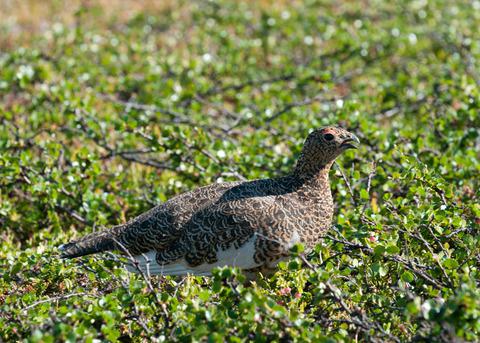当前位置:
X-MOL 学术
›
J. Appl. Ecol.
›
论文详情
Our official English website, www.x-mol.net, welcomes your
feedback! (Note: you will need to create a separate account there.)
Accounting for food web dynamics when assessing the impact of mesopredator control on declining prey populations
Journal of Applied Ecology ( IF 5.0 ) Pub Date : 2020-11-07 , DOI: 10.1111/1365-2664.13793 John‐André Henden 1 , Dorothee Ehrich 1 , Eeva M. Soininen 1 , Rolf A. Ims 1
中文翻译:

在评估中粒繁殖者控制对猎物数量下降的影响时考虑食物网动态
更新日期:2021-01-07
Journal of Applied Ecology ( IF 5.0 ) Pub Date : 2020-11-07 , DOI: 10.1111/1365-2664.13793 John‐André Henden 1 , Dorothee Ehrich 1 , Eeva M. Soininen 1 , Rolf A. Ims 1
Affiliation

|
- Increasing populations of mesopredators are suspected to cause declines in vulnerable wildlife to the extent that mesopredator decimation actions (culling) have become commonplace. Design constraints, especially a lack of spatial replication, often hamper the assessment of the impact of such actions. However, extensive temporal replication (i.e. time series) and accounting for potentially confounding variables may alleviate this problem.
- In alpine‐arctic tundra, the red fox Vulpes vulpes is increasing, while many bird species are declining, likely due to increased predation. Here, we assessed the impact of a long‐term (12‐year) and spatially extensive (~3,500 km2) red fox culling action on the red‐listed willow ptarmigan Lagopus lagopus in the Norwegian Arctic. Ptarmigan populations were monitored annually in the impact area and in an adjacent no‐action area, including a 5‐year period before the action commenced. While logistical constraints prohibited monitoring of red fox population densities, the number of culled foxes and three influential food web covariates were monitored after the onset of the culling action.
- A Before‐After‐Control‐Impact‐Paired‐Series (BACIPS) analysis without food web covariates indicated that red fox culling curbed the decline of the population in the impact area, and that ptarmigan population density became ~25% higher than in the reference area.
- Spatially and temporally variable drivers within the food web confounded the simple BACIPS analysis. Accounting for three food web drivers as covariates in a linear mixed model after the onset of action, yielded a more unbiased impact estimate that amounted to ~40% higher ptarmigan population density (4.3 more ptarmigan/km2) in the red fox impact area.
- Synthesis and applications. We provide the first evidence of the role of the recent expansion of red fox in the decline of bird populations in tundra. We also show that red fox culling may be able to curb such declines, given that management actions are large scale and long term. As mesopredator culling campaigns are often expensive and controversial, it is important that their impacts are accurately assessed. We demonstrate that the accuracy of impact assessments can be profoundly increased by monitoring drivers of food web dynamics that impinge on the target species so that such drivers can be included as covariates in the analysis. This applies in particular to declining bird populations in boreal and arctic food webs ruled by strong multi‐annual interaction cycles.
中文翻译:

在评估中粒繁殖者控制对猎物数量下降的影响时考虑食物网动态
- 怀疑中指繁殖者的增加会导致易受攻击的野生动植物数量减少,以至中指繁殖者的抽取行动(扑杀)变得司空见惯。设计约束,尤其是缺乏空间复制,经常会妨碍对此类操作的影响进行评估。但是,广泛的时间复制(即时间序列)和考虑潜在的混淆变量可以缓解此问题。
- 在高山北极苔原,赤狐赤狐正在增加,而许多鸟类都在下降,可能是由于增加了捕食。在这里,我们评估了长期(12年)和空间上广泛(约3500 km 2)的红狐扑杀行动对挪威北极红名单中雷鸟雷鸟Lagopus lagopus的影响。每年在影响区和邻近的无行动区(包括行动开始前的5年)内对雷鸟种群进行监测。尽管后勤限制禁止监测赤狐种群密度,但在扑杀行动开始后,对扑杀狐狸的数量和三个有影响的食物网协变量进行了监测。
- 在没有食物网协变量的情况下进行的事前对事前配对(BACIPS)分析表明,红狐剔除抑制了受影响地区人口的下降,雷鸟种群的密度比参考地区高约25%。区。
- 食物网中的时空驱动因素混淆了简单的BACIPS分析。在行动开始后,在线性混合模型中将三个食物网驱动因素视为协变量,得出的影响估计更加无偏见,在赤狐影响地区的雷鸟种群密度提高了约40%(雷鸟/ km 2增加了4.3 )。
- 综合与应用。我们提供了第一个证据,说明最近红狐的扩张在冻原中鸟类数量下降中的作用。我们还表明,鉴于管理行动是大规模的长期行动,赤狐的扑杀或许能够遏制这种下降。由于中子扑杀活动通常很昂贵且存在争议,因此准确评估其影响非常重要。我们证明,通过监视影响目标物种的食物网动态驱动因素,可以大大提高影响评估的准确性,从而可以将这些驱动因素作为协变量包括在分析中。这尤其适用于由强大的多年交互周期控制的北方和北极食物网中鸟类的数量减少。











































 京公网安备 11010802027423号
京公网安备 11010802027423号